A Ring Of Fire Eclipse In The Southern Hemisphere
A Ring of Fire Eclipse in the Southern Hemisphere
On Feb. 26, a “ring of fire” will be visible in the sky above parts of the Southern Hemisphere, including Chile, Argentina and Angola. This is called an annular eclipse.

Credit: Dale Cruikshank
If you live within the viewing area, even though most of the sun will be obscured by the moon, it’s essential to observe eye safety. This includes using a proper solar filter or an indirect viewing method during ALL phases of this eclipse.

See full graphic
What is an annular eclipse? During any type of solar eclipse, the sun, moon, and Earth line up, allowing the moon to cast its shadow on Earth’s surface in a partial or total solar eclipse.

Download this animation
An annular eclipse is the product of almost the same celestial geometry as a total solar eclipse – that is, from the perspective of some place on Earth, the moon crosses in front of the sun's center.
But an annular eclipse is different in one important way – the moon is too far from Earth to obscure the sun completely, leaving the sun’s edges exposed and producing the “ring of fire” effect for which annular eclipses are known. Because the moon’s orbit is slightly oblong, its distance from Earth – and therefore its apparent size compared to the sun’s – is constantly changing.

An annular eclipse seen in extreme ultraviolet light – a type of light invisible to humans – by the Hinode spacecraft on Jan. 4, 2011.
Any time part, or all, of the sun’s surface is exposed – whether during an annular eclipse, a partial eclipse, or just a regular day – it’s essential to use a proper solar filter or an indirect viewing method to view the sun. You can NEVER look directly at the sun, and an annular eclipse is no exception!

If you live in the Southern Hemisphere or near the equator, check this interactive map for partial eclipse times.
If you live in North America, you’ll have a chance to see an eclipse later this year. On Aug. 21, 2017, a total solar eclipse will cross the US – the first total solar eclipse in the contiguous US in nearly 40 years! The path of totality for the August eclipse runs from coast to coast.

Within this narrow path of totality, the moon will completely obscure the sun – unlike an annular eclipse – revealing the sun’s outer atmosphere. People in other parts of North America will see a partial solar eclipse, weather permitting. Find out what you can see during the Aug. 21, 2017, eclipse in your area with our maps, and explore the rest of eclipse2017.nasa.gov for more information.
For more eclipse science, visit www.nasa.gov/eclipse.
Make sure to follow us on Tumblr for your regular dose of space: http://nasa.tumblr.com
More Posts from Nasa and Others
Why Do X-Ray Mirrors Look So Unusual?

Does the object in this image look like a mirror? Maybe not, but that’s exactly what it is! To be more precise, it’s a set of mirrors that will be used on an X-ray telescope. But why does it look nothing like the mirrors you’re familiar with? To answer that, let’s first take a step back. Let’s talk telescopes.
How does a telescope work?
The basic function of a telescope is to gather and focus light to amplify the light’s source. Astronomers have used telescopes for centuries, and there are a few different designs. Today, most telescopes use curved mirrors that magnify and focus light from distant objects onto your eye, a camera, or some other instrument. The mirrors can be made from a variety of materials, including glass or metal.

Space telescopes like the James Webb and Hubble Space Telescopes use large mirrors to focus light from some of the most distant objects in the sky. However, the mirrors must be tailored for the type and range of light the telescope is going to capture—and X-rays are especially hard to catch.
X-rays versus mirrors
X-rays tend to zip through most things. This is because X-rays have much smaller wavelengths than most other types of light. In fact, X-rays can be smaller than a single atom of almost every element. When an X-ray encounters some surfaces, it can pass right between the atoms!

Doctors use this property of X-rays to take pictures of what’s inside you. They use a beam of X-rays that mostly passes through skin and muscle but is largely blocked by denser materials, like bone. The shadow of what was blocked shows up on the film.
This tendency to pass through things includes most mirrors. If you shoot a beam of X-rays into a standard telescope, most of the light would go right through or be absorbed. The X-rays wouldn’t be focused by the mirror, and we wouldn’t be able to study them.

X-rays can bounce off a specially designed mirror, one turned on its side so that the incoming X-rays arrive almost parallel to the surface and glance off it. At this shallow angle, the space between atoms in the mirror's surface shrinks so much that X-rays can't sneak through. The light bounces off the mirror like a stone skipping on water. This type of mirror is called a grazing incidence mirror.
A metallic onion
Telescope mirrors curve so that all of the incoming light comes to the same place. Mirrors for most telescopes are based on the same 3D shape — a paraboloid. You might remember the parabola from your math classes as the cup-shaped curve. A paraboloid is a 3D version of that, spinning it around the axis, a little like the nose cone of a rocket. This turns out to be a great shape for focusing light at a point.

Mirrors for visible and infrared light and dishes for radio light use the “cup” portion of that paraboloid. For X-ray astronomy, we cut it a little differently to use the wall. Same shape, different piece. The mirrors for visible, infrared, ultraviolet, and radio telescopes look like a gently-curving cup. The X-ray mirror looks like a cylinder with very slightly angled walls.
The image below shows how different the mirrors look. On the left is one of the Chandra X-ray Observatory’s cylindrical mirrors. On the right you can see the gently curved round primary mirror for the Stratospheric Observatory for Infrared Astronomy telescope.

If we use just one grazing incidence mirror in an X-ray telescope, there would be a big hole, as shown above (left). We’d miss a lot of X-rays! Instead, our mirror makers fill in that cylinder with layers and layers of mirrors, like an onion. Then we can collect more of the X-rays that enter the telescope, giving us more light to study.

Nested mirrors like this have been used in many X-ray telescopes. Above is a close-up of the mirrors for an upcoming observatory called the X-ray Imaging and Spectroscopy Mission (XRISM, pronounced “crism”), which is a Japan Aerospace Exploration Agency (JAXA)-led international collaboration between JAXA, NASA, and the European Space Agency (ESA).
The XRISM mirror assembly uses thin, gold-coated mirrors to make them super reflective to X-rays. Each of the two assemblies has 1,624 of these layers packed in them. And each layer is so smooth that the roughest spots rise no more than one millionth of a millimeter.

Why go to all this trouble to collect this elusive light? X-rays are a great way to study the hottest and most energetic areas of the universe! For example, at the centers of certain galaxies, there are black holes that heat up gas, producing all kinds of light. The X-rays can show us light emitted by material just before it falls in.
Stay tuned to NASA Universe on Twitter and Facebook to keep up with the latest on XRISM and other X-ray observatories.
Make sure to follow us on Tumblr for your regular dose of space!
Tune in, Starliner! How NASA’s Near Space Network Powers Communications

On May 19, 2022, our partners at Boeing launched their Starliner CST-100 spacecraft to the International Space Station as a part of our Commercial Crew Program. This latest test puts the company one step closer to joining the SpaceX Crew Dragon in ferrying astronauts to and from the orbiting laboratory. We livestreamed the launch and docking at the International Space Station, but how? Let’s look at the communications and navigation infrastructure that makes these missions possible.

Primary voice and data communications are handled by our constellation of Tracking and Data Relay Satellites (TDRS), part of our Near Space Network. These spacecraft relay communications between the crewed vehicles and mission controllers across the country via terrestrial connections with TDRS ground stations in Las Cruces, New Mexico, and Guam, a U.S. territory in the Pacific Ocean.
TDRS, as the primary communications provider for the space station, is central to the services provided to Commercial Crew vehicles. All spacecraft visiting the orbiting laboratory need TDRS services to successfully complete their missions.

During launches, human spaceflight mission managers ensure that Commercial Crew missions receive all the TDRS services they need from the Near Space Operations Control Center at our Goddard Space Flight Center in Greenbelt, Maryland. There, communications engineers synthesize network components into comprehensive and seamless services for spacecraft as they launch, dock, undock, and deorbit from the space station.

Nearby, at our Flight Dynamics Facility, navigation engineers track the spacecraft on their ascent, leveraging years of experience supporting the navigation needs of crewed missions. Using tracking data sent to our Johnson Space Center in Houston and relayed to Goddard, these engineers ensure astronaut safety throughout the vehicles’ journey to the space station.
Additionally, our Search and Rescue office monitors emergency beacons on Commercial Crew vehicles from their lab at Goddard. In the unlikely event of a launch abort, the international satellite-aided search and rescue network will be able to track and locate these beacons, helping rescue professionals to return the astronauts safely. For this specific uncrewed mission, the search and rescue system onboard the Boeing Starliner will not be activated until after landing for ground testing.

To learn more about NASA’s Space Communications and Navigation (SCaN) services and technologies, visit https://www.nasa.gov/directorates/heo/scan/index.html. To learn more about NASA’s Near Space Network, visit https://esc.gsfc.nasa.gov/projects/NSN.
Make sure to follow us on Tumblr for your regular dose of space!
Solar System: Things to Know This Week
10 Tools for the Armchair Astronaut, or How to Explore the Solar System from Home
At this very moment, spacecraft are surveying the solar system, from Mars, to Saturn, to Pluto and beyond. Now you can ride along to see the latest discoveries from deep space. For this week's edition of 10 Things, we've assembled a toolkit of 10 essential resources for the desktop astronaut.

1. It's Like Facebook, but for Planets
Or is it more of a Hitchhiker's Guide to the Solar System? Whatever one calls it, our planets page offers quick rundowns, as well as in-depth guides, for all the major bodies in the solar system. Explore from the sun all the way to the Oort Cloud.
+ Peruse the planets + See how objects in the solar system stack up against each other

2. Keep Your Eyes on This One
If you still haven't tried Eyes on the Solar System, you're missing out. This free, downloadable simulation app lets you tour the planets and track the past, current and future positions of spacecraft--all in 3D. Eyes on the Solar System uses real NASA data to help you take a virtual flight across both space and time.
+ Prepare for departure

3. Dateline: Deep Space
With so much exploration underway, discoveries and new insights into the solar system come at a pace that borders on bewildering. NASA is rewriting the textbooks, literally, on a regular basis. Relax, though: there are several easy ways to stay up to date with what's happening in space.
+ See the latest headlines + Stay connected on social media: Twitter, Facebook, Instagram + Find more top NASA social media accounts

4. Space? There's an App for That
NASA offers phone and tablet apps for star gazing, pictures, news, 3D tours, satellite tracking, live NASA TV and many other kinds of info.
+ Start downloading + See other cool apps

5. A (Very) Long Distance Call
We’re in constant communication with spacecraft all over the solar system. The Deep Space Network is a global network of giant antenna dishes that makes it possible. With this online app, you can learn how it works -- and even see which spacecraft are phoning home right now.
+ Deep Space Network (DSN) Now

6. Collect 'Em All
Spacecraft 3D is an augmented reality (AR) application that lets you learn about and interact with a variety of spacecraft that are used to explore our solar system, study Earth and observe the universe. Print out the AR target and your camera will do the rest, making the spacecraft appear in 3D right in front of you. Learn more about these robotic explorers as they pop up on your desk, in your hand, or on your dog's head.
+ Download Spacecraft 3D + See more cool 3-D resources from NASA

7. Ever Wanted to Drive a Mars Rover?
This site will give you a 3D look at the Mars Curiosity rover, along with some of the terrain it has explored. It will even let you take the controls.
+ Experience Curiosity

8. More E-Ticket Attractions
But wait, there's more. NASA offers a variety of other fascinating (and free) online experiences, all based on actual data from real missions. Here are a few to explore:
+ Mars Trek + Vesta Trek + Moon Trek

9. The Universe Is Our Classroom
Studying the solar system makes for a compelling route into learning and teaching science, engineering and math. We have some great places to start.
+ Find resources for teachers + Build your own solar system with your classroom

10. Bring It on Home
After you've toured the far reaches of the solar system, you can always come home again. When you have spent time studying the harsh conditions on our neighboring planets, the charms of a unique paradise come into sharp focus, the place we call Earth.
+ Watch a real-time video feed from Earth orbit + See a daily global view of our planet from a million miles away + Hold the earth in your hands with the Earth Now mobile app
Discover more lists of 10 things to know about our solar system HERE.
Follow us on Tumblr for your regular dose of space: http://nasa.tumblr.com
When you're finally up out of the air, high enough to see the Earth, what is it like to see our home planet from above for the first time?
Here’s What Actually Happens Inside Our Lunar Lab
Water is a precious resource -- especially on the Moon! In the near future, robotic rovers may roam the Moon’s poles in search of hidden reservoirs of water beneath the lunar surface. But traversing the poles can be a perilous journey. Depending on the Sun’s position in the sky and the way that its light falls on the surface, hazards such as boulders and craters can be difficult, if not impossible, to see.

Inside our Lunar Lab at Ames Research Center, researchers are using Hollywood light kits and a giant sandbox filled with 8 tons of artificial Moon dirt to simulate driving conditions at the poles. The research aims to provide rovers and their human supervisors with 3-D hazard maps of the Moon’s terrain, helping them to avoid potential obstacles that lie ahead.
Here’s how it works:
STEP 1: GENERATE A MOON MAP

Researchers begin with a map of the Moon’s terrain that’s randomly generated by a computer. Each scene is based on observations made from lunar orbit. The map indicates the number, location and size of features like rocks and craters that should be placed inside the 12x12-foot testbed.
STEP 2: BUILD A MOONSCAPE

Using the map as a guide, researchers build the terrain by hand with everyday tools. The terrain is then dusted with a top layer of artificial Moon dirt to eliminate shovel and brush marks.
STEP 3: CAPTURE IMAGES

Lights are positioned at different locations around the testbed. One by one, the lights are switched on and off while a camera captures images of the terrain. Notice how the appearance of the terrain changes depending on the source of illumination.
STEP 4: CREATE A 3-D MODEL

Using a computer algorithm, a 3-D hazard detection model of the terrain is generated from the images. The model provides important information about the size of an obstacle, its height and where it’s located.
STEP 5: GO EXPLORING

With this technique, researchers can teach a rover to recognize the effect of different lighting conditions on the Moon’s poles. The tool could come in handy for future lunar rover missions like Resource Prospector, which will use a drill to search for subsurface water and other compounds on the Moon.
Make sure to follow us on Tumblr for your regular dose of space: http://nasa.tumblr.com
10 Questions About the 2017 Astronaut Class
We will select between eight and 14 new astronaut candidates from among a record-breaking applicant class of more than 18,300, almost three times the number of applications the agency received in 2012 for the recent astronaut class, and far surpassing the previous record of 8,000 in 1978.

The candidates will be announced at an event at our Johnson Space Center in Houston, Texas at 2 p.m. EDT on June 7. You can find more information on how to watch the announcement HERE.
1. What are the qualifications for becoming an astronaut?

Applicants must meet the following minimum requirements before submitting an application.
Bachelor’s degree from an accredited institution in engineering, biological science, physical science, computer science or mathematics.
Degree must be followed by at least 3 years of related, progressively responsible, professional experience or at least 1,000 hours of pilot-in-command time in jet aircraft
Ability to pass the NASA Astronaut physical.
For more information, visit: https://astronauts.nasa.gov/content/faq.htm
2. What have selections looked like in the past?

There have been 22 classes of astronauts selected from the original “Mercury Seven” in 1959 to the most recent 2017 class. Other notable classes include:
The fourth class in 1965 known as “The Scientists: because academic experience was favored over pilot skills.
The eighth class in 1978 was a huge step forward for diversity, featuring the first female, African American and Asian American selections.
The 16th class in 1996 was the largest class yet with 44 members – 35 U.S. astronauts and 9 international astronauts. They were selected for the frequent Space Shuttle flights and the anticipated need for International Space Station crewmembers.
The 21st class in 2013 was the first class to have 50/50 gender split with 4 female members and 4 male members.
3. What vehicles will they fly in?

They could be assigned on any of four different spacecraft: the International Space Station, our Orion spacecraft for deep space exploration or one of two American-made commercial crew spacecraft currently in development – Boeing’s CST-199 Starliner or the SpaceX Crew Dragon.
4. Where will they go?

These astronauts will be part of expanded crews aboard the space station that will significantly increase the crew time available to conduct the important research and technology demonstrations that are advancing our knowledge for missions farther into space than humans have gone before, while also returning benefits to Earth. They will also be candidates for missions beyond the moon and into deep space aboard our Orion spacecraft on flights that help pave the way for missions to Mars.
5. What will their roles be?

After completing two years of general training, these astronaut candidates will be considered full astronauts, eligible to be assigned spaceflight missions. While they wait for their turn, they will be given duties within the Astronaut Office at Johnson Space Center. Technical duties can range from supporting current missions in roles such as CAPCOM in Mission Control, to advising on the development of future spacecraft.
6. What will their training look like?

The first two years of astronaut candidate training will focus on the basic skills astronauts need. They’ll practice for spacewalks in Johnson’s 60-foot deep swimming pool, the Neutral Buoyancy Lab, which requires SCUBA certification. They’ll also simulate bringing visiting spacecraft in for a berthing to the space station using its robotic arm, Canadarm2, master the ins and outs of space station system and learn Russian.

And, whether they have previous experience piloting an aircraft of not, they’ll learn to fly our fleet of T-38s. In addition, they’ll perfect their expeditionary skills, such as leadership and fellowship, through activities like survival training and geology treks.
7. What kinds of partners will they work with?

They will join a team that supports missions going on at many different NASA centers across the country, but they’ll also interact with commercial partners developing spaceflight hardware. In addition, they will work with our international partners around the globe: ESA (the European Space Agency, the Canadian Space Agency, the Japan Aerospace Exploration Agency and the Russian space agency, Roscosmos.
8. How does the selection process work?

All 18,353 of the applications submitted were reviewed by human resources experts to determine if they met the basic qualifications. Those that did were then each reviewed by a panel of about 50 people, made up primarily of current astronauts. Called the Astronaut Rating Panel, that group narrowed to applicants down to a few hundred of what they considered the most highly qualified individuals, whose references were then checked.

From that point, a smaller group called the Astronaut Selection Board brought in the top 120 applicants for an intense round of interviews and some initial medical screening tests. That group is further culled to the top 50 applicants afterward, who are brought back for a second round of interviews and additional screening. The final candidates are selected from that group.
9. How do they get notified?

Each applicant selected to become an astronaut receives a phone call from the head of the Flight Operations Directorate at our Johnson Space Center and the chief of the astronaut office. They’re asked to share the good news with only their immediate family until their selection has been officially announced.
10. How does the on boarding process work?

Astronaut candidates will report for duty at Johnson Space Center in August 2017, newly fitted flight suits in tow, and be sworn into civil service. Between their selection and their report for duty, they will make arrangements to leave their current positions and relocate with their family to Houston, Texas.
Make sure to follow us on Tumblr for your regular dose of space: http://nasa.tumblr.com

These three towers are only a small portion of the massive Eagle Nebula.
Known as the “Pillars of Creation,” the beautiful tendrils of cosmic dust and gas are giving birth to new stars, buried within their spires. This iconic image only shows a stretch of about four or five light-years … while the whole nebula itself spans about 70 by 55 light-years.
Learn more about Hubble’s celebration of Nebula November and see new nebula images, here.
You can also keep up with Hubble on Twitter, Instagram, Facebook, and Flickr!
Image credits: NASA, ESA and the Hubble Heritage Team (STScI/AURA)
One Year Into Our Planet-Hunting TESS Mission

Our Transiting Exoplanet Survey Satellite (TESS), launched last year on April 18, is completing a year in space, surveying the skies to find the closest, most exciting planets outside our solar system for further study. Worlds that TESS is hunting for include super-Earths, rocky planets, gas giants, and maybe even some Earth-sized planets — and much, much more! TESS is scanning the whole sky one section at a time, monitoring the brightness of stars for periodic dips caused by planets transiting (that is, passing in front of) those stars. So far, TESS has found 548 candidates and 10 confirmed exoplanets.

Since its launch, TESS has orbited Earth a total of 28 times. TESS has a unique elliptical orbit that circuits around Earth twice every time the Moon orbits. This allows TESS’s cameras to monitor each patch of sky continuously for nearly a month at a time. To get into this special orbit, TESS made a series of loops culminating in a lunar gravitational assist, which gave it the final push it needed.

Did you know that TESS has some serious mileage? The spacecraft has traveled about 20 million miles so far, which works out to an average of about 2,200 miles per hour. That’s faster than any roadrunner we’ve ever seen! This would be four times faster than an average jet. You’d get to your destination in no time!

TESS downloads data during its closest approach to Earth about every two weeks. So far, it has returned 12,000 gigabytes of data. That’s as if you streamed about 3,000 movies on Netflix. Get the popcorn ready! If you total all the pixels from every image taken using all four of the TESS cameras — which is about 600 full-frame images per orbit, you’d get about 805 billion pixels. This is like half a million iPhone screens put together!

When the Kepler Space Telescope reached the end of its mission, it passed the planet-finding torch to TESS. Where Kepler's view was deep — looking for planets as far away as 3,000 light-years — TESS's view is wide, surveying nearly the entire sky over two years. Each sector TESS views is 20 times larger than Kepler's field of view.

TESS will continue to survey the sky and is expected to find about 20,000 exoplanets in the two years it'll take to complete a scan of nearly the entire sky. Before TESS, several thousand candidate exoplanets were found, and more than 3,000 of these were confirmed. Some of these exoplanets are expected to range from small, rocky worlds to giant planets, showcasing the diversity of planets in the galaxy.
The TESS mission is led by MIT and came together with the help of many different partners. You can keep up with the latest from the TESS mission by following mission updates and keep track of the number of candidates and confirmed exoplanets.
Make sure to follow us on Tumblr for your regular dose of space: http://nasa.tumblr.com.
First All-Woman Spacewalk
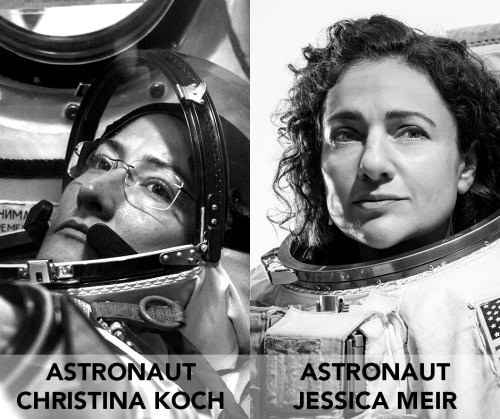
NASA astronauts and best friends, Christina Koch and Jessica Meir, made history Friday, October 18, 2019, by conducting the first all-woman spacewalk outside the International Space Station (ISS)! The Expedition 61 flight engineers ventured into the vacuum of space at 7:38 a.m. EDT to swap out a failed power controller that regulates the batteries used to collect and distribute power to the orbital laboratory – a task that took a total of seven hours and 17 minutes to complete.
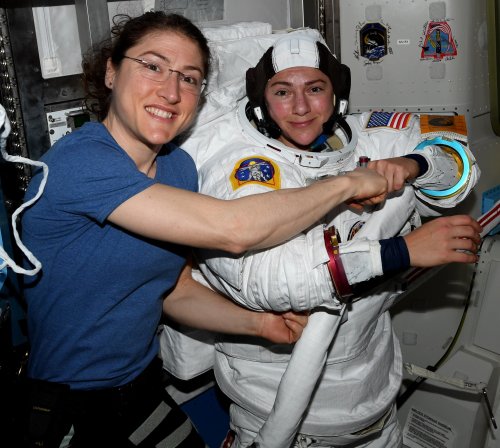
This was Koch’s fourth spacewalk and Meir’s first. Both women, selected as astronaut candidates in 2013, are on their first trip to work and live aboard the space station. Meir will be the 15th woman to spacewalk, and the 14th U.S. woman.
Get to know the astronauts
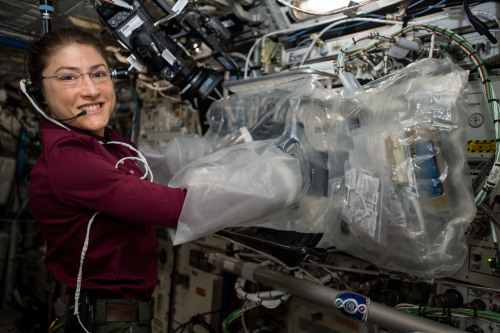
In addition to being an astronaut, Christina Koch is an engineer and physicist. Her career has taken her to extreme parts of the planet to conduct scientific field missions in places like the Antarctic South Pole and Greenland’s Summit Station. Prior to being selected as an astronaut candidate in 2013, she worked as an Electrical Engineer at our Goddard Space Flight Center’s Laboratory for High Energy Astrophysics.
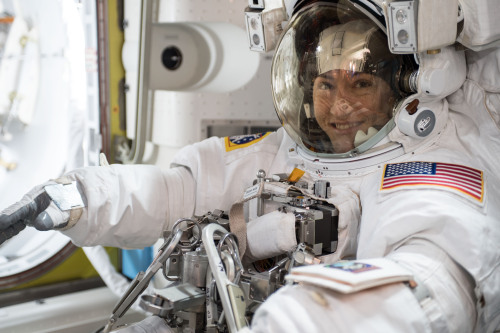
Koch left Earth on March 14, 2019, and is slated to set a record for the longest single spaceflight by a woman with an expected total of 328 days in space. Her extended mission will provide researchers the opportunity to observe the effects of long-duration spaceflight on a female body in preparation for human missions to the Moon and Mars.
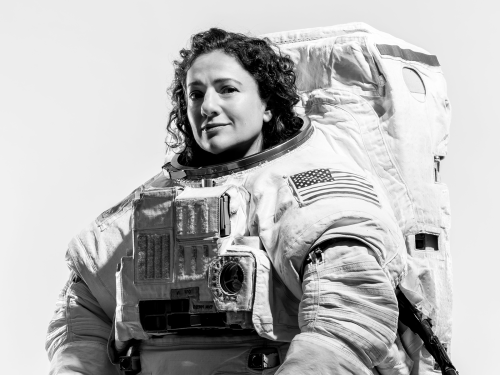
Jessica Meir dreamed of the day she would make it to space since the age of five. That dream became a reality on Wednesday, Sept. 25, 2019 as she left Earth on her first spaceflight – later floating into her new home aboard the International Space Station.
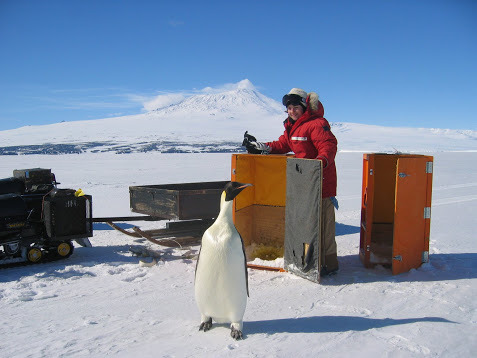
While Meir’s new home is more than 200 miles over the Earth, she is no stranger to extreme environments. She studied penguins in Antarctica and mapped caves in Italy – both of which prepared her for the ultimate extreme environment: space.
#AllWomanSpacewalk, what’s the deal?
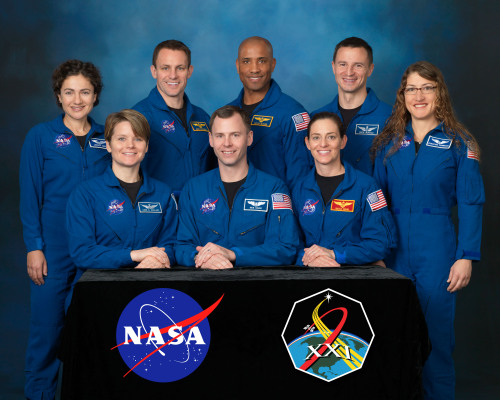
The all-woman spacewalk wasn’t something we purposefully planned; it is a testament to the increasing number of female astronauts in the space program. For example, Koch’s and Meir’s 2013 class of astronaut candidates was 50 percent women!
When asked in an interview about the importance of conducting her mission and this spacewalk, Koch said,
“In the end, I do think it’s important, and I think it’s important because of the historical nature of what we’re doing. In the past women haven’t always been at the table. It’s wonderful to be contributing to the space program at a time when all contributions are being accepted, when everyone has a role. That can lead in turn to increased chance for success. There are a lot of people who derive motivation from inspiring stories of people who look like them, and I think it’s an important story to tell.”
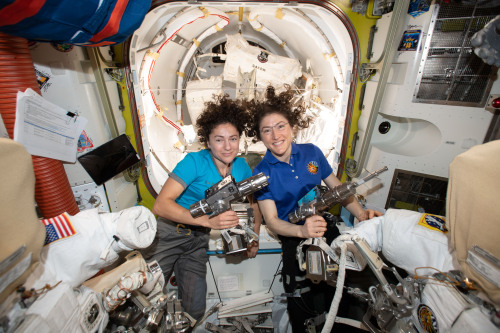
It’s important to note that spacewalks are not easy; astronauts typically describe them as the most physically challenging thing they do. Assignments are made on the basis of which astronauts are the best prepared to accomplish the tasks at hand under the conditions at the time. Today, Koch and Meir were the top astronauts for the job.
Women are no stranger to spacewalks!

While this was the first spacewalk to be conducted entirely by women, women are no strangers to spacewalks. Exactly 35 years and one week ago, Kathryn Sullivan (pictured above) made her own historic debut as the first U.S. woman to conduct a spacewalk. Since then, a total of 14 women (15 including Jessica) have ventured into the vacuum of space on 40 different spacewalks. Former Astronaut Peggy Whitson performed a record number of 10! From Astronauts to mission directors, women have been making their mark at the agency for decades now. A few of our recent pioneers are:
Astronaut Kate Rubins: First person to sequence DNA in space
Astronaut Peggy Whitson: First woman to command the ISS
Sandra Cauffman: Director of our Earth Science’s Division
Nicola Fox: Director of our Heliophysics Division
Lori Glaze: Director of our Planetary Science Division
Coming soon: The first woman to walk on the Moon
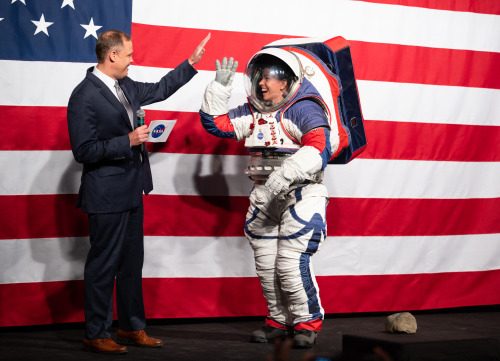
The first all-woman spacewalk is a milestone worth noting and celebrating as we look forward to putting the first woman and the next man on the Moon by 2024 with our Artemis lunar exploration program. With today’s historic event, we once again set a precedence for women to lead in space exploration.
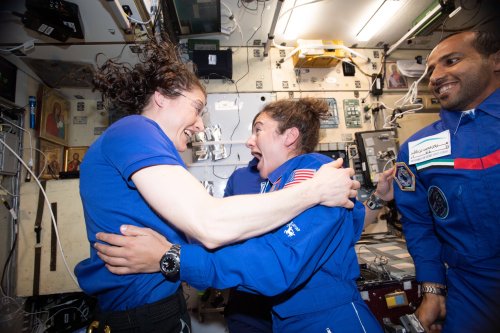
We hope achievements such as this provide inspiration to you all around the world, proving that hard work can lead you to great heights. This is not just a historic day for NASA, but a moment we can all feel proud of.
Didn’t have time to tune in? Check out the replay, here. Koch was wearing the spacesuit with red stripes, while Meir’s had no stripes.
If you’d like to keep up with Christian Koch and Jessica Meir’s work 254 miles above planet Earth, follow them on Twitter at @Astro_ Christina and @Astro_Jessica.
Be sure to follow us on Tumblr for your regular dose of space: http://nasa.tumblr.com
-
 batjohnsmithme liked this · 5 years ago
batjohnsmithme liked this · 5 years ago -
 ignaciovanburen liked this · 5 years ago
ignaciovanburen liked this · 5 years ago -
 mayax81 reblogged this · 5 years ago
mayax81 reblogged this · 5 years ago -
 mayax81 liked this · 5 years ago
mayax81 liked this · 5 years ago -
 izzys-life-1324-blog liked this · 7 years ago
izzys-life-1324-blog liked this · 7 years ago -
 purpurella-v liked this · 7 years ago
purpurella-v liked this · 7 years ago -
 ellisq257-blog liked this · 7 years ago
ellisq257-blog liked this · 7 years ago -
 prisonerinheaven reblogged this · 7 years ago
prisonerinheaven reblogged this · 7 years ago -
 prisonerinheaven liked this · 7 years ago
prisonerinheaven liked this · 7 years ago -
 gogameg liked this · 7 years ago
gogameg liked this · 7 years ago -
 rafalchuknoxious reblogged this · 8 years ago
rafalchuknoxious reblogged this · 8 years ago -
 rafalchuknoxious liked this · 8 years ago
rafalchuknoxious liked this · 8 years ago -
 clairvoyant-fry-cook reblogged this · 8 years ago
clairvoyant-fry-cook reblogged this · 8 years ago -
 wholesomegrains-blog liked this · 8 years ago
wholesomegrains-blog liked this · 8 years ago -
 unwillingarmpit liked this · 8 years ago
unwillingarmpit liked this · 8 years ago -
 wollyv1 liked this · 8 years ago
wollyv1 liked this · 8 years ago -
 laffincat liked this · 8 years ago
laffincat liked this · 8 years ago -
 dimaski65-blog reblogged this · 8 years ago
dimaski65-blog reblogged this · 8 years ago -
 dimaski65-blog liked this · 8 years ago
dimaski65-blog liked this · 8 years ago -
 jei-diadem liked this · 8 years ago
jei-diadem liked this · 8 years ago -
 sylvermyth reblogged this · 8 years ago
sylvermyth reblogged this · 8 years ago -
 prim1717-blog reblogged this · 8 years ago
prim1717-blog reblogged this · 8 years ago -
 stoner-wolff-blog liked this · 8 years ago
stoner-wolff-blog liked this · 8 years ago -
 poisonous-owl liked this · 8 years ago
poisonous-owl liked this · 8 years ago -
 kimbermcleod reblogged this · 8 years ago
kimbermcleod reblogged this · 8 years ago -
 withywindlesdaughter liked this · 8 years ago
withywindlesdaughter liked this · 8 years ago -
 fvillha liked this · 8 years ago
fvillha liked this · 8 years ago -
 dsp8589-blog liked this · 8 years ago
dsp8589-blog liked this · 8 years ago -
 leiorganas liked this · 8 years ago
leiorganas liked this · 8 years ago -
 liviconnor reblogged this · 8 years ago
liviconnor reblogged this · 8 years ago -
 fayebelle reblogged this · 8 years ago
fayebelle reblogged this · 8 years ago
Explore the universe and discover our home planet with the official NASA Tumblr account
1K posts